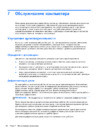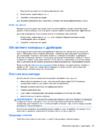D-Link DWL-2600AP [53/128] Wpa personal
![D-Link DWL-2600AP [53/128] Wpa personal](/views2/1203431/page53/bg35.png)
Unied Access Point Administrator’s Guide
Unied Access Point Administrator’s Guide
Page 53
March 2012
Section 4 - Managing the Access Point
Field Description
Enable RADIUS
Accounting
Select this option to track and measure the resources a particular user has consumed
such as system time, amount of data transmitted and received, and so on.
If you enable RADIUS accounting, it is enabled for the primary RADIUS server and all
backup servers.
Enable RADIUS
FailThrough
Select this option to allow the secondary RADIUS server to authenticate wireless clients if
the authentication with the primary RADIUS server is unsuccessful, or if the primary RADIUS
server is unavailable.
Active Server Specify which congured RADIUS server to use as the active RADIUS server.
Broadcast Key
Refresh Rate
Enter a value to set the interval at which the broadcast (group) key is refreshed for clients
associated to this VAP (the default is 300).
The valid range is 0 – 86400 seconds. A value of 0 indicates that the broadcast key is not
refreshed.
Session Key
Refresh Rate
Enter a value to set the interval at which the AP will refresh session (unicast) keys for each
client associated to the VAP.
The valid range is 0 – 86400 seconds. A value of 0 indicates that the broadcast key is not
refreshed.
Table 24 - IEEE 802.1X
Note: After you congure the security settings, you must click Apply to apply the changes and to
save the settings.
WPA Personal
WPA Personal is a Wi-Fi Alliance IEEE 802.11i standard, which includes AES-CCMP and TKIP mechanisms. The
Personal version of WPA employs a pre-shared key (instead of using IEEE 802.1X and EAP as is used in the
Enterprise WPA security mode). The PSK is used for an initial check of credentials only.
This security mode is backwards-compatible for wireless clients that support the original WPA.
Figure 25 - Modify Virtual Access Point Settings (WPA Personal)
Field Description
WPA Versions Select the types of client stations you want to support:
•) WPA. If all client stations on the network support the original WPA but none support the
newer WPA2, then select WPA.
•) WPA2. If all client stations on the network support WPA2, we suggest using WPA2
which provides the best security per the IEEE 802.11i standard.
•) WPA and WPA2. If you have a mix of clients, some of which support WPA2 and others
which support only the original WPA, select both of the check boxes. This lets both
WPA and WPA2 client stations associate and authenticate, but uses the more robust
WPA2 for clients who support it. This WPA conguration allows more interoperability,
at the expense of some security.
Содержание
- Section 1 about this document p.2
- Section 4 managing the access point 5 p.2
- Section 2 getting started 1 p.2
- Table of contents p.2
- Section 3 viewing access point status 2 p.2
- Section 9 clustering multiple aps 04 p.3
- Section 8 configuring client quality of service qos 8 p.3
- Section 7 maintaining the access point 9 p.3
- Section 6 configuring snmpv3 5 p.3
- Section 5 configuring access point services 5 p.3
- Appendix c statements 27 p.4
- Appendix b configuration examples 15 p.4
- Appendix a default ap settings 13 p.4
- List of figures p.5
- List of tables p.7
- Section 1 about this document p.9
- Document organization p.9
- Document conventions p.9
- Additional documentation p.9
- Online help supported browsers and limitations p.10
- Section 2 getting started p.11
- Administrator s computer requirements p.11
- Wireless client requirements p.12
- Recovering an ip address p.13
- Installing the uap p.13
- Dynamic and static ip addressing on the ap p.13
- Discovering a dynamically assigned ip address p.13
- Basic settings p.16
- Using the cli to view the ip address p.17
- Connecting to the ap web interface by using the ipv6 address p.17
- Using the cli to configure ethernet settings p.18
- Configuring the ethernet settings p.18
- If your network uses ieee 802 x see configuring ieee 802 x authentication on page 19 for information about how to configure 802 x by using the web interface p.19
- Unified access point administrator s guide p.19
- Set the static ip address p.19
- Set the default gateway p.19
- Set dns nameservers to use static ip addresses dynamic to manual mode p.19
- Set dns nameservers to use dhcp ip addressing manual to dynamic mode p.19
- Set a subnet mask p.19
- Section 2 getting started p.19
- On networks that use ieee 802 x port based network access control a supplicant client cannot gain access to the network until the 802 x authenticator grants access if your network uses 802 x you must configure 802 x authentication information that the ap can supply to the authenticator p.19
- March 2012 p.19
- In the following example the administrator uses the cli to set the management vlan id to 123 and to disable the untagged vlan so that all traffic is tagged with a vlan id p.19
- For example p.19
- View the dns nameserver mode dynamic up manual down p.19
- Configuring ieee 802 x authentication p.19
- Action commands p.19
- Use dhcp as the connection type p.19
- Use a static ip as the connection type p.19
- Unified access point administrator s guide page 19 p.19
- Verifying the installation p.20
- Using the cli to configure 802 x authentication information p.20
- Configuring security on the wireless access point p.21
- Wireless settings p.22
- Wired settings internal interface p.22
- Viewing interface status p.22
- Section 3 viewing access point status p.22
- Viewing events p.23
- Configuring persistent logging options p.23
- Enabling or disabling the log relay host on the events page p.24
- Configuring the log relay host for kernel messages p.24
- Viewing transmit and receive statistics p.25
- Viewing tspec client associations p.26
- Viewing associated wireless client information p.26
- Viewing rogue ap detection p.28
- Link integrity monitoring p.28
- Saving and importing the known ap list p.30
- Viewing tspec status and statistics information p.31
- Viewing managed ap dhcp information p.31
- Viewing tspec ap statistics information p.32
- Viewing radio statistics information p.33
- Viewing email alert operational status p.34
- Section 4 managing the access point p.35
- Ethernet settings p.35
- Wireless settings p.37
- Using the 802 1h wireless mode p.39
- Enabling aeroscout engine support p.39
- Modifying radio settings p.40
- Configuring radio and vap scheduler p.44
- Scheduler association settings p.46
- Virtual access point settings p.47
- Static wep p.50
- None plain text p.50
- Ieee 802 x p.51
- Wpa personal p.53
- Wpa enterprise p.54
- Configuring the wireless distribution system wds p.56
- Wpa psk on wds links p.58
- Wep on wds links p.58
- Controlling access by mac authentication p.59
- Configuring a mac filter and station list on the ap p.59
- Configuring mac authentication on the radius server p.60
- Configuring load balancing p.60
- Managed access point overview p.61
- Transitioning between modes p.61
- Configuring managed access point settings p.62
- Configuring 802 x authentication p.63
- Creating a management access control list acl p.64
- Web server settings p.65
- Section 5 configuring access point services p.65
- Configuring snmp on the access point p.66
- Setting the ssh status p.68
- Setting the telnet status p.69
- Configuring quality of service p.69
- Configuring email alert p.72
- Enabling the time settings ntp p.73
- Section 6 configuring snmpv3 p.75
- Configuring snmpv3 views p.75
- Configuring snmpv3 groups p.76
- Configuring snmpv3 users p.77
- Configuring snmpv3 targets p.78
- Section 7 maintaining the access point p.79
- Saving the current configuration to a backup file p.79
- Restoring the configuration from a previously saved file p.80
- Upgrading the firmware p.81
- Resetting the factory default configuration p.81
- Rebooting the access point p.81
- Performing ap maintenance p.81
- Packet capture status p.83
- Packet capture configuration and settings p.83
- Packet file capture p.84
- Packet capture parameter configuration p.84
- Remote packet capture p.85
- Packet capture file download p.87
- Section 8 configuring client quality of service qos p.88
- Configuring vap qos parameters p.88
- Managing client qos acls p.89
- Ipv4 and ipv6 acls p.89
- Mac acls p.90
- Acl configuration process p.90
- Creating a diffserv class map p.95
- Defining diffserv p.96
- Creating a diffserv policy map p.100
- Client qos status p.101
- Configuring radius assigned client qos parameters p.102
- Unified access point administrator s guide page 103 p.103
- Unified access point administrator s guide p.103
- Section 8 configuring client quality of service qos p.103
- Radius attribute id description type range p.103
- March 2012 p.103
- Managing cluster access points in the cluster p.104
- Clustering aps p.104
- Viewing and configuring cluster members p.104
- Section 9 clustering multiple aps p.104
- Removing an access point from the cluster p.106
- Navigating to configuration information for a specific ap p.106
- Navigating to an ap by using its ip address in a url p.106
- Managing cluster sessions p.106
- Adding an access point to a cluster p.106
- Sorting session information p.107
- Stopping starting automatic channel assignment p.108
- Configuring and viewing channel management settings p.108
- Viewing the last proposed set of changes p.109
- Viewing current channel assignments and setting locks p.109
- Configuring advanced settings p.109
- Viewing wireless neighborhood information p.110
- Viewing details for a cluster member p.112
- Appendix a default ap settings p.113
- Vap configuration from the web interface p.115
- Vap configuration from the cli p.115
- Configuring a vap p.115
- Appendix b configuration examples p.115
- Vap configuration using snmp p.116
- Configuring radio settings p.116
- Radio configuration from the web interface p.117
- Radio configuration from the cli p.117
- Wds configuration from the web interface p.118
- Radio configuration using snmp p.118
- Configuring the wireless distribution system p.118
- Wds configuration using snmp p.119
- Wds configuration from the cli p.119
- Clustering aps by using the web interface p.119
- Clustering access points p.119
- Clustering aps by using snmp p.120
- Clustering aps by using the cli p.120
- Configuring qos by using the web interface p.121
- Configuring client qos p.121
- Configuring qos by using the cli p.124
- Appendix c statements p.127
Похожие устройства
-
 D-Link DWL-8710APРуководство пользователя
D-Link DWL-8710APРуководство пользователя -
 D-Link DWL-8710APБрошюра
D-Link DWL-8710APБрошюра -
 D-Link DWL-8610APРуководство пользователя
D-Link DWL-8610APРуководство пользователя -
 D-Link DWL-8610APБрошюра
D-Link DWL-8610APБрошюра -
 D-Link DWL-6700APРуководство пользователя
D-Link DWL-6700APРуководство пользователя -
 D-Link DWL-6700APБрошюра
D-Link DWL-6700APБрошюра -
 D-Link DWL-6610APРуководство пользователя
D-Link DWL-6610APРуководство пользователя -
 D-Link DWL-6610APБрошюра
D-Link DWL-6610APБрошюра -
 D-Link DWL-6600APРуководство пользователя
D-Link DWL-6600APРуководство пользователя -
 D-Link DWL-6600APБрошюра
D-Link DWL-6600APБрошюра -
 D-Link DWL-3600APРуководство пользователя
D-Link DWL-3600APРуководство пользователя -
 D-Link DWL-3600APБрошюра
D-Link DWL-3600APБрошюра
![D-Link DWL-2600AP [53/128] Wpa personal](/img/pdf.png)
























